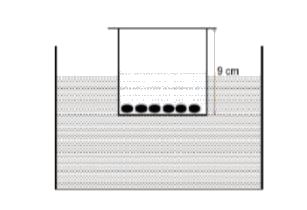A clay ball of mass m and speed v strikes another metal ball. of same mass m, which is at rest. They stick together after collision. The kinetic energy of the system after collision is –
The correct Answer is:B
Step by step video, text & image solution for A clay ball of mass m and speed v strikes another metal ball. of same mass m, which is at rest. They stick together after collision. The kinetic energy of the system after collision is – by Physics experts to help you in doubts & scoring excellent marks in Class 12 exams.
Updated on:21/07/2023Topper's Solved these Questions
Similar Questions
A wide bottom cylindrical massless plastic container of height 9 cm has 40 identical coins inside it and is floating on water with 3 cm inside the water. If we start putting more of such coins on its lid. It is observed that after N coins are put, its equilibrium changes from stable to unstable. Equilibrium in floating is stable if the geometric center of the submerged portion is above the center of mass of the object) The value of N is closed to

View SolutionA ball of mass m moving at a speed v makes a head on inelastic collision with an identical ball at rest. The kinetic energy of the balls after the collision is 3/4th of the original. Find the coefficient of restitution.
View SolutionA ball of mass m moving at speed v makes a head on collision with an identical ball at rest. The kinetic energy of the balls after the collision is 3//4th of the original. Find the coefficient of restitution.
View SolutionA ball of mass m moving with a velocity v undergoes an oblique elastic collision with another ball of the same mass m but at rest. After the collision if the two balls move with the same speeds , the angle between their directions of motion will be:
View SolutionX- अक्ष में, 0.1 किग्रा द्रव्यमान की एक गेंद 4.0 मीटर/सेकण्ड के वेग से गति करती हुई, उसी दिशा में 3.0 मीटर/सेकण्ड के वेग से गतिशील 0.2 किग्रा की दूसरी गेंद से टकराती है। टक्कर के बाद प्रथम गेंद 2.0 मीटर/सेकण्ड के वेग से वापिस लौटने लगती है। दूसरी गेंद की टक्कर के बाद गतिज ऊर्जा के गणना कीजिए ।
View SolutionOn a frictionless surface, a ball of mass m moving at a speed v makes a head on collision with an identical ball at rest. The kinetic energy of the balls after the collision is 3/4th of the original. Find the coefficient of restitution.
View SolutionA billiard ball of mass M , moving with velocity v1 collides with another ball of the same mass but at rest . If the collision is elastic , the angle of divergence after the collision is
View SolutionA billiard ball of mass M , moving with velocity v1 collides with another ball of the same mass but at rest . If the collision is elastic , the angle of divergence after the collision is
View SolutionA ball of mass m moving at a speed v makes a head-on collision with an identical ball at rest. The kinetic energy of the balls after the collision is three fourths of the original. Find the coefficient of restitution.
View SolutionA billiard ball of mass M , moving with velocity v1 collides with another ball of the same mass but at rest . If the collision is elastic , the angle of divergence after the collision is
View SolutionA ball of mass 'm' moving at a speed v makes a head on collision with an identical ball at rest. The kinetic energy of balls after the collision is 3/4th of the origial. If e is the coefficient of restitution, then :
View SolutionA ball of mass m moving with a speed v makes a head on collision with an identical ball at rest. The kinetic energy after collision of the balls is three fourth of the original kinetic energy. The coefficient of restitution is
View SolutionA ball of mass m moving at a speed v makes a head on inelastic collision with an identical ball at rest. The kinetic energy of the balls after the collision is 3/4th of the original. Find the coefficient of restitution.
View SolutionA particle of mass m moving with a speed v strikes a stationary particle of mass 2 m and sticks to it. The speed of the system after collision will be
View SolutionA metal ball of mass 2 kg moving with a velocity of 36km/h has a head on collision with a stationery ball of mass 3 kg. If after the collision, the two balls move together, the loss in kinetic energy dur to collision is
View Solution
